
Shrimp fry stocking is a crucial stage at the start of the shrimp farming cycle. Farmers need to choose the proper stocking method since it affects shrimp survival and growth throughout the farming cycle.
The proper shrimp fry stocking method reduces stress on the fry, increases shrimp survival rate, and minimizes the harmful impacts of shrimp diseases. In the long term, choosing the proper shrimp fry stocking method can help farmers avoid financial losses.
One of the tools farmers can use to conduct shrimp fry stocking is a conical tank. What is a conical tank and what are its advantages? What are the steps for stocking shrimp fry using a conical tank? Find the answers in the discussion below.





